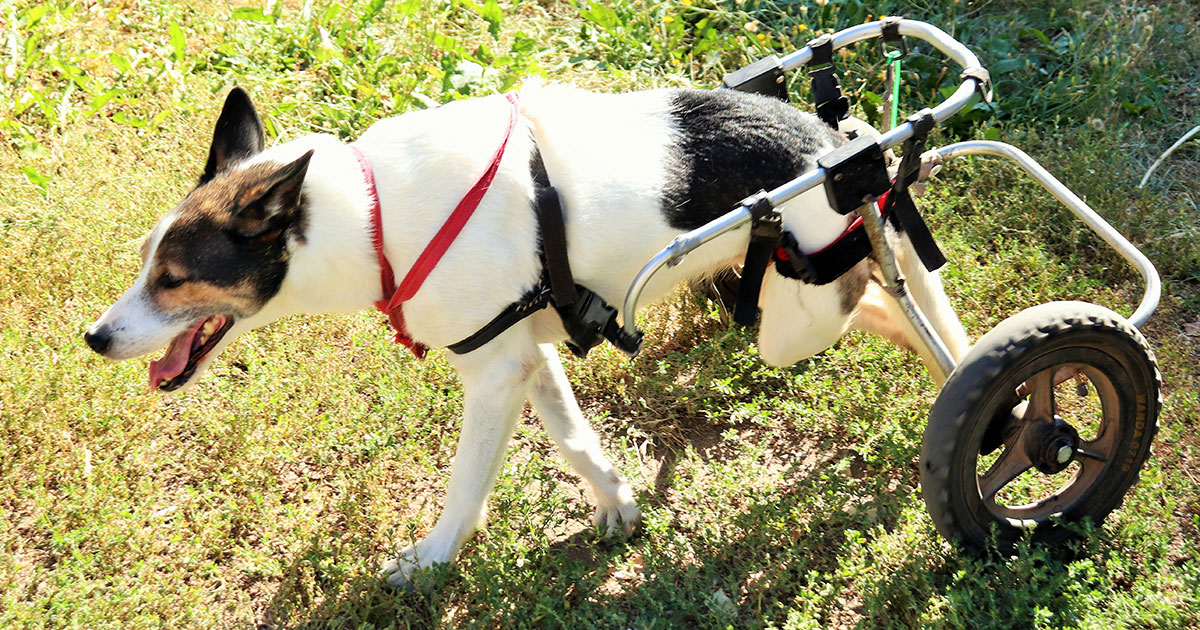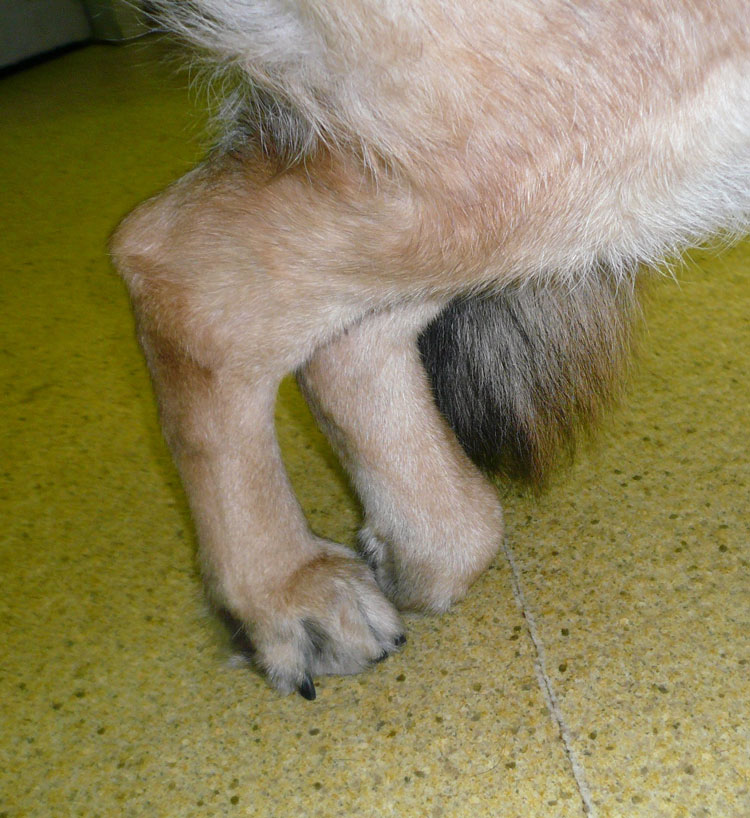31 Aug 2022
Degenerative myelopathy in dogs: symptoms and treatments

Image © uslan / Adobe Stock
First described in 1973 and heavily researched since then, degenerative myelopathy (DM) remains a mysterious illness with unknown causal mechanisms. It is hard to diagnose and easily confused with other diseases of the nervous system.
Before any definitive solution to this deadly disease can be enacted, dog owners and veterinarians have the responsibility to optimise the end-of-life phase for their canine patients.
What is it?
Degenerative myelopathy (DM), also known as chronic degenerative radiculomyelopathy, breaks down the myelin sheath around nerve fibres in the white matter of the spinal cord. The human equivalent is amyotrophic lateral sclerosis, colloquially known as Lou Gehrig’s disease.
Spinal deterioration causes nerves to lose their ability to transmit impulses, first to the hindlegs and later to the rest of the body as the degeneration spreads from the thoracolumbar section.
In the final stage, the disease progresses to the brain stem, causing a gradual loss of the ability to breathe.
It is believed that DM is the result of a dog’s immune system perceiving its own nervous system as a threat and attacking it.
This disease correlates to an inherited genetic mutation of the SOD1 gene.

Are all breeds susceptible?
The genetic risk factor is most prevalent in the German shepherd, husky and collie1. Several other breeds are at high risk2-5, including:
- American Eskimo
- Hovawart
- Soft-coated wheaten terrier
- Australian shepherd dog
- Dutch shepherd dog
- Kerry blue terrier
- Weimaraner6
- Bernese mountain dog
- Kuvasz
- Welsh corgi
- Boxer7
- Dalmatian
- Nova Scotia duck tolling retriever8
- Wirehaired fox terrier
- Chesapeake Bay retriever
- Poodle
- Borzoi
- Pug
- Golden retriever
- Rhodesian ridgeback
- Shetland sheepdog
- Pyrenean mountain dog
- Samoyed
At what age does DM typically occur?
The condition tends to strike middle-aged and senior dogs5. Larger dogs often get it after the age of eight, and smaller dogs after age 11. It is rare but possible for dogs as young as four to develop DM.
Is this the end?
The estimated survival time from presumptive prognosis is anywhere from six months to three years9. Unfortunately, it is often on the shorter side of that range.
There is a light in the darkness, though. Misdiagnosis is a possibility, since diagnosis is a lengthy and involved procedure that includes tests such as:
- MRI
- CT
- diffusion tensor imaging (DTI)
- scans with digital x-ray machines
- CSF analysis
- tissue biopsies
- DNA testing
- myelography
- neuromuscular tests
The symptoms of DM are similar to those pertaining to OA10 and other neurological disorders in dogs11, such as meningomyelitis and lumbosacral disease. It can also be confused with spinal cord tumours and orthopedic conditions.
The other good news is that while DM is a progressive neurodegenerative disease, it is not a painful one. Affected dogs will be very weak, but any pains that arise are most likely due to secondary effects like arthritis.
That brings the opportunity to start a new beginning. Even with their body on a downhill slope, a dog can still have an enjoyable period leading up to the final stages of the disease.
Activities like walking and swimming have been shown to decelerate the onset of graver symptoms12.
What are the symptoms?
Canine degenerative myelopathy occurs in three stages. In the early stage, ataxia (wobbling) is observed in the pelvic limbs. Symptoms can start with one hindleg, and only become noticeable when the dog is squatting or jumping.
Other observable behaviors include:
- tremors, weakness and lack of coordination in the legs
- wobbling and swaying as if drunk
- spastic, long-strided gait
- knuckling the paws when walking
- dragging feet
- stumbling and falling – especially on slippery surfaces
- limp tail
- difficulty rising
- inability to correct posture
- appearance of uneasiness or uncertainty when walking
Especially prominent weakness and wobbling distinguish DM from OA of the hip. Owners should not delay a visit to the vet when they start seeing ongoing symptoms.
In the intermediate stage, the initial symptoms will worsen. The ambulatory paresis (weakness) makes way for non-ambulatory paresis.
Inability to walk typically sets in within six to nine months after the earliest signs5.
Other middle-stage symptoms include:
- inability to hold weight with the hindlegs
- muscular atrophy in the shoulders
- hairless and damaged toes from dragging feet
- difficulty lying down
- jerky movements due to nerves misfiring
- crossed extensor response (touching one paw causes the other to react)
The advanced stage can come on quickly and involves a progression toward paraplegia, with forelimbs being affected as well (tetraparesis).
DM includes several other final-stage symptoms:
- displays of pain and anxiety
- systemic infections
- widespread muscle mass loss
- difficulty swallowing (dysphagia)
- voice changes
- bladder and bowel incontinence
- sclerotic lesions
- pressure sores and ulcers
- compromised respiration
- multisystem failure, including kidneys, lungs and heart
Euthanasia should be considered prior to this stage if the animal is distressed.

Treatment options
No definitive treatment for degenerative myelopathy exists. Therapies are mostly aimed at delaying degeneration and improving quality of life.
Based on a study by Iris Kathmann at the University of Bern in Switzerland, physiotherapy combined with hydrotherapy proved the best treatment to stimulate firing of nerve impulses, delay loss of mobility and decelerate muscle atrophy12.
Staircases, treats for luring, walks on soft grass, Cavaletti rails, cones, underwater treadmills, balance pads, and wobble cushions are helpful methods and tools. Overexertion, however, can be counterproductive.
A more artificial way to stimulate muscle activity is electrotherapy. This is helpful in more advanced stages13 where it takes over the role of the CNS.
Electrotherapy is performed using a neuromuscular electrical stimulation machine and improves muscular function while reducing pain.
Strong evidence exists that laser therapy is another effective treatment for dogs with DM14. Also known as photobiomodulation therapy, low-power, non-thermal lasers penetrate the skin to energise cells. This causes downstream effects, such as pain modulation and accelerated tissue healing.
Surgery is not advised15 since digital x-rays will show no compression on the spinal cord to be alleviated. Surgery also impedes dogs from maintaining a physical activity schedule.
Preventing obesity is an important task for pet owners, as is spending quality time with a canine companion on its final journey.
Nutrition
Few studies have proven dietary management to be effective in combating the relentlessness of degenerative myelopathy16. Still, veterinary specialists suggest that anti-inflammatory foods work best to limit oxidative stress on the spinal cord17. This also means avoiding processed foods and starchy dog kibble.
Vitamin C, E and A, carotenoids, selenium, and coenzyme Q10 are all powerful antioxidants that can be found in fruits and vegetables. It is wise for owners to mix these in with their dog’s meals18.
Polyunsaturated fatty acids, such as omega-3, are essential18 and can be found in fish oil, fresh or canned. Owners can also consider adding supplements like fibrinolytics.
Methylsulfonylmethane also has alleged anti-inflammatory properties, and can be found in red meat, poultry, eggs and asparagus.
To relieve discomfort and stress in pets, cannabidiol is a controversial treatment19. Derived from hemp plants, CBD interacts with the brain’s endocannabinoid system to produce a variety of effects on the body. While moderate risk exists in giving CBD to pets, THC is high-risk for dogs and should never be given to pets20.
Finally, some anti-inflammatory herbs may be able to provide relief18, such as:
- ginseng
- ginkgo
- green tea
- curcumin21
- bromelain
- feverfew
Assistive products
A plethora of solutions are available to keep dogs as active as can be, despite the debilitating circumstances that DM entails. Numerous companies offer high-quality mobility carts to keep pets running in the short-term.
A drag bag is an alternative for spaces unfit for wheelchair navigation and boots help to reduce chafing injuries. A rear-lifting harness is another alternative to taking walks outside.
Stroller carts are more expensive and yet critical in enabling dogs to still venture outside when the disease has progressed to paraplegia.
Indoors, non-slip mats and flat-padded memory foam bedding can be used to prevent discomfort due to the dog’s reduced ability to move. Bedding can be covered with sheets to absorb urine leaks and proactive measures can be taken to prevent the onset of pressure sores.
Final word
The effects of combined treatments for DM can be powerful, extending an animal’s lifespan by several months or even more than a year12.
By ensuring proper clinical treatment, home care, outdoor activity and humane euthanasia, dog owners can ease this uncomfortable process.
